The Bon Monastery in Gangtok is a unique place and speaks of stories from a very old religion that prevailed before Buddhism. It was established in the 1980s by Yung Dung Tsultrim, who has since passed away. This Monastery stands strong for the Bon religion, which is the original faith of Tibet, even though Buddhism is widespread too. The building’s architecture itself depicts a combination of Indian and Tibetan designs, reflecting the fact that it bears a lot of historical depth. Inside, drums, conch shells, red-robed monks, a quiet courtyard, and the whispering wind remind one of the history here.
Bon Monastery Location
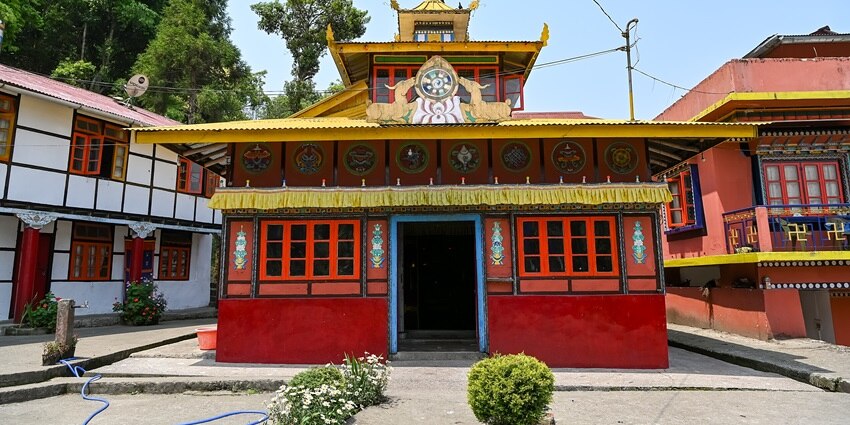
Photo: Anjan Kumar Kundu / Wikimedia Commons
Bon Monastery, also known as Bon Yung Dung Monastery, is located in the South district of Sikkim. It is situated on a hill with stunning mountain views. The nearest town is Ravangla, which is approximately 6 kilometres away.
Suggested Read: Your Complete Guide For Trekking In Gangtok
How To Reach Bon Monastery
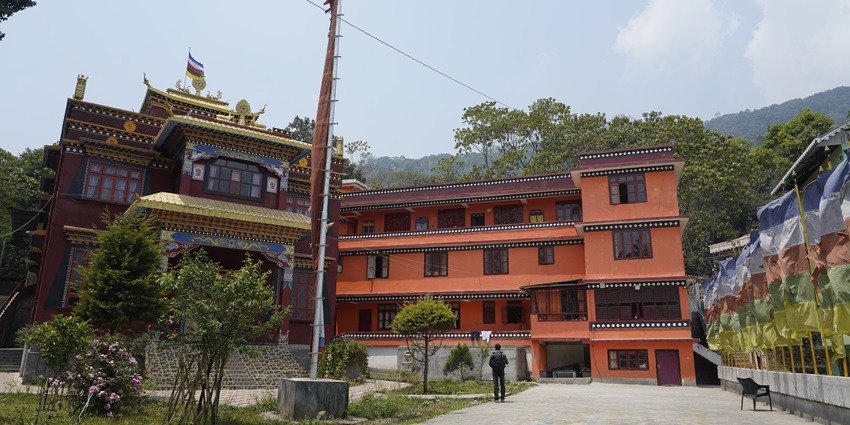
Photo: Amitabha Gupta / Wikimedia Commons
The monastery can be conveniently reached via road from Bagdogra International Airport or New Jalpaiguri Railway Station in West Bengal.
By Road: This is the most common way to reach Bon Monastery. Visitors can either drive their car or hire a taxi from nearby towns like Gangtok, Pelling, or Geyzing.
- From Gangtok, the drive is approximately 68 kilometres and takes about 2-3 hours.
- From Pelling, about 38 kilometres, it takes approximately 1 hour and 45 minutes.
- Geyzing is another option; it’s shorter than the others located 29 kilometres away, with a travel time of roughly 1 hour and 13 minutes.
Places To Visit In And Around Bon Monastery
The Bon Monastery is a serene and peaceful place in Gangtok, Sikkim. There are various places to visit in and around Bon Monastery.
1. Buddha Park
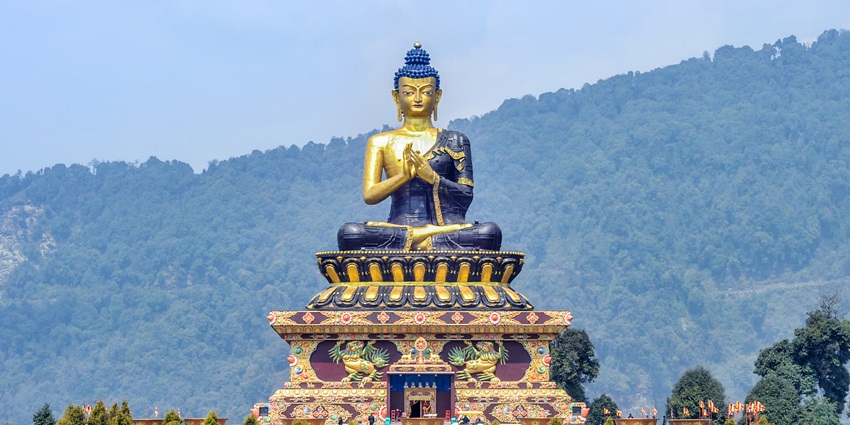
Photo: Joydeep / Wikimedia Commons
Situated in Ravangla, Buddha Park is a peaceful retreat in the Himalayas with a 130-foot-tall Gautama Buddha statue. It is an expanse of green, with soothing walking paths and a centrally located fountain accompanied by prayer flags with wishes. The golden hues of the statue reflect the feeling of inner peace, and in the backdrop, the mightiness of the Himalayas presents itself in all its majesty. It also encompasses a museum with paintings elaborating on the life of Buddha, thus allowing insight into his path to enlightenment.
Timings: From 9:00 AM to 6:00 PM
Entry Fee: INR 50/- to 100/-
Suggested Read: Offbeat Places Near Gangtok
2. Ralang Monastery
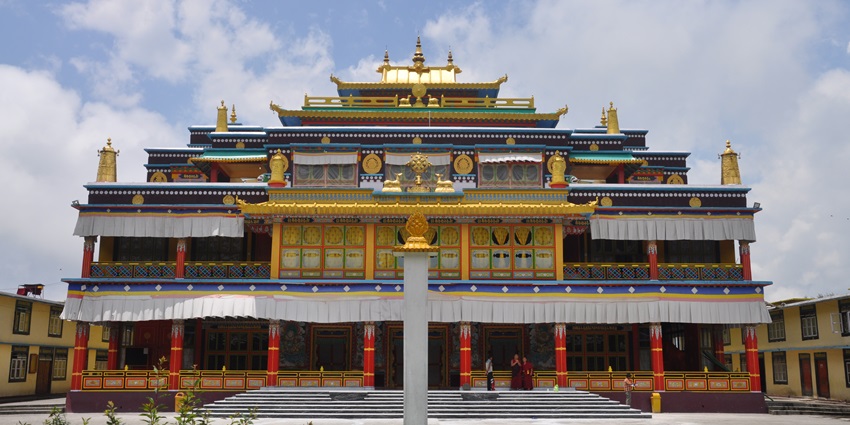
Photo: Prof Ranga Sai / Wikimedia Commons
It is a spiritual haven that provides tranquil conditions for spiritual enlightenment. The monastery was built in 1768 AD by the Kagyupa lineage of Tibetan Buddhism. The original monastery, built in 1768, testifies to the Kagyupa Lineage. The tiring pilgrimage was eased with the start of the Palchen Choeling Monastic Institute in 1995. In these monastery walls, one finds intricate murals depicting stories of Buddhas, gods, and the middle path of Buddhism. Just outside the monastery, breathtaking beauty is offered by the Kanchenjunga mountain range. Ralang is a cultural repository and a window into the soul of Sikkim.
Timings: From 8:00 AM to 5:00 PM
Entry Fee: Free Entry
3. Temi Tea Estate
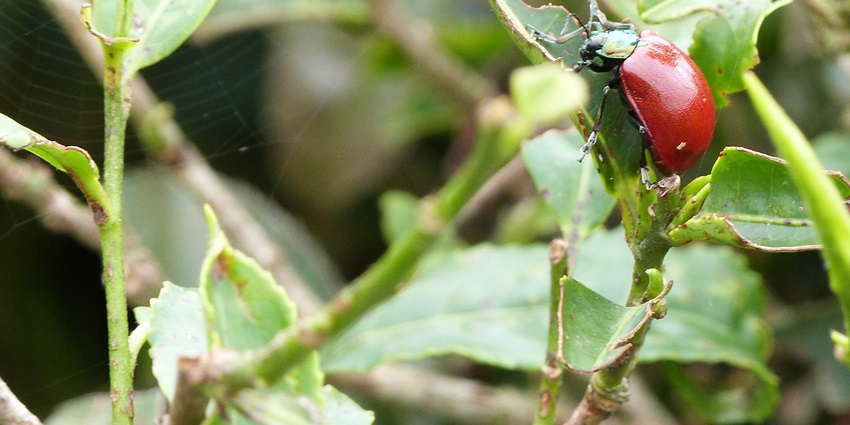
Photo: Sushan Ghosh / Wikimedia Commons
This paradise is an amalgamation of the best of nature, tradition, and the finest organic tea in the world. Spread over an area of 440 acres, it was established in the year 1969, with the enchanting Tendong Hill landscape surrounding it. Temi’s commitment to an organic process devoid of any artificial chemical fertilisers or pesticides makes for a cup full of flavour and aroma. Visitors get to experience the withering, rolling, oxidation, and firing process up close, watching the hands of the workers pluck leaves from the bushes effortlessly.
Timings: From 9:00 AM to 5:00 PM
Entry Fee: INR 20/-
Suggested Read: The Best Adventure Sports In Sikkim To Try On Your Next Vacation
4. Ralang Hot Springs
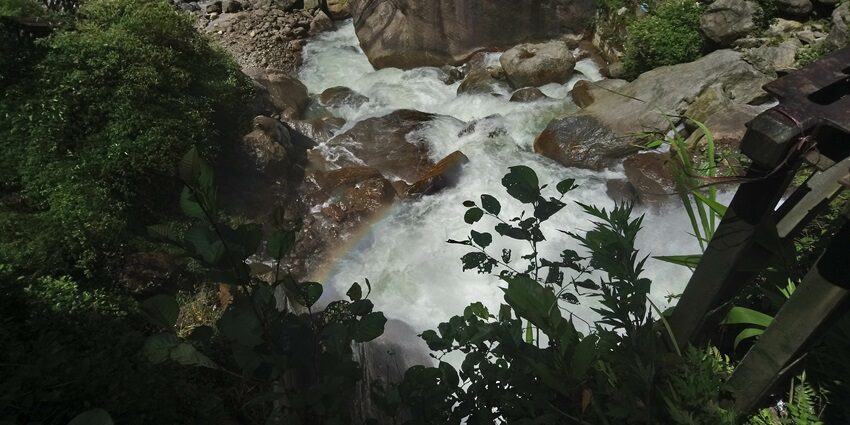
Photo: Prabhat114 / Wikimedia Commons / Image For Representation Only
Ralang Hot Springs in South Sikkim is the perfect getaway to rejuvenate your body and soul. Legend has it that somewhere near the hot springs is a mystic cave enveloped by greenery. For that very reason, an ancient energy is hanging in the air, asking wayfarers to relax and let their worries melt away. Right from the journey, adventure awaits at Ralang, which is beautiful with its valley and village hike. It relieves stiff muscles, is rich in minerals, and is good for skin conditions. Moreover, it rejuvenates and reunites with nature and solace in the Himalayas.
Timings: Open 24/7
Best Time To Visit: March to May and September to November
5. Kheunpheling Carpet Center
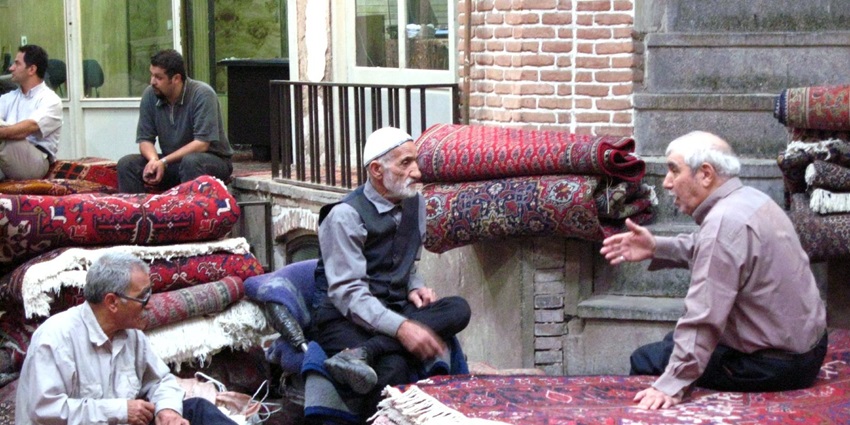
Photo: Fulvio Spada / Wikimedia Commons / Image For Representation Only
The Kheunpheling Carpet Centre in Ravangla, Sikkim, is a kaleidoscope of cultural heritage, artistic mastery, and bonding between humans. Since it has been a Tibetan refugee settlement camp since 1978, this centre brings out the rich art of Tibetan carpet weaving, which is like a bridge between the past and the present. Very intricate carpets with vibrant colours and symbols narrate stories of enlightenment and eternity. Visitors can meet artisans, listen to stories of their past, and watch a weaving demonstration. This centre is a window into another culture and is a show of the human soul’s indestructibility.
Timings: Monday to Friday from 8:00 AM to 5:00 PM
Entry Fee: Free Entry
Suggested Read: Cascading Waterfalls In Sikkim That Are Not To Be Missed
Where To Stay
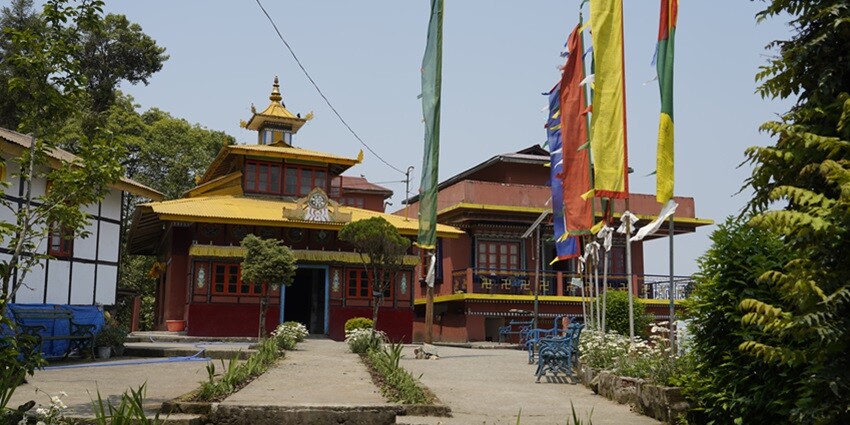
Photo: Amitabha Gupta / Wikimedia Commons
Sikkim offers a plethora of accommodation facilities to pilgrims and travellers. Some of the popular ones are Norbulingka Retreat, The Barfung Retreat, Sosing Homestay Kewzing Ravangla, Mt Narsing Resort and many more. Accommodations are available in various budgets; parking, Wi-Fi, and dining facilities are also provided in some accommodations.
Where To Eat
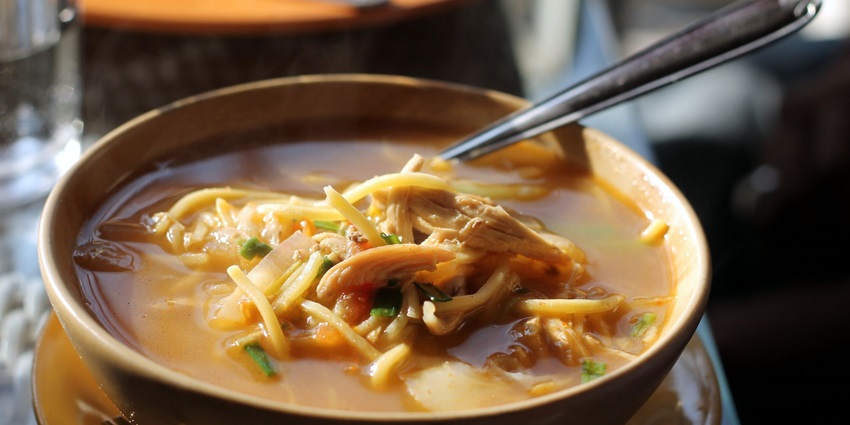
Photo: Arunabha.Goswami / Wikimedia Commons
Savour food in Lotus Bakery, Grains by Udaan PineCrest, Taste of Sikkim, Hilltop Rabong Resort, Roots & Shoots and many more options are available; one is sure to get a good mix of local flavours and dishes familiar to all.
Suggested Read: Discovering The Best Food In Gangtok
Best Time To Visit Bon Monastery

Photo: Amitabha Gupta / Wikimedia Commons
The Bon Monastery is best visited during spring (March to May), with pleasant weather and clear skies. Summer (June to August) brings mild temperatures and lush greenery, while autumn (September to November) offers comfortable sightseeing and beautiful views of the Kanchenjunga mountain range. Winter (December to February) transforms Sikkim into a wonderland with temperatures dropping significantly and snowfall. The Bon Monastery remains open during winter, but some roads may be inaccessible due to snow.
Other Factors To Consider
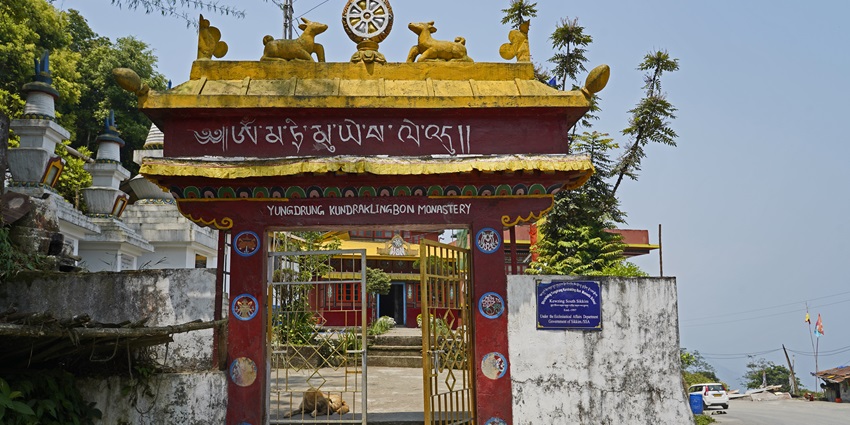
Photo: Amitabha Gupta / Wikimedia Commons
Here are some factors to consider before you take a trip to Bon Monastery:
Average Cost Of the Trip: There is no entrance fee at the Bon Monastery. Additional expenses may include transportation, offering items, food, and refreshments. The estimated cost would be from INR 2000/- to 6000/- per day.
Tips For Travellers:
- Take care as a responsible traveller, and do not litter in the temple complex.
- Dress modestly—covering your shoulders and your knees—since you will be entering places of worship.
- Show due respect to the local customs and traditions.
Suggested Read: Explore A Different Side Of Sikkim By Witnessing The Nightlife In Gangtok
The Bon Monastery is an old and sacred Buddhist place of worship that provides a calm and culturally interesting visit. It is essential for the growth of Buddhism in this area, and tourists can visit places for meditation and other nearby attractions. With TripXL’s support, travelling becomes effortless and enriching; each journey to Bon Monastery becomes a memorable and enriching experience.
Photo: Amitabha Gupta / Wikimedia Commons


 WhatsApp
WhatsApp
 Twitter
Twitter









